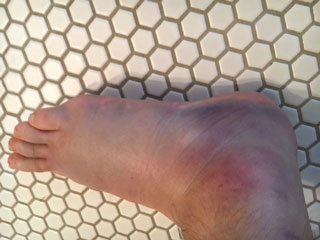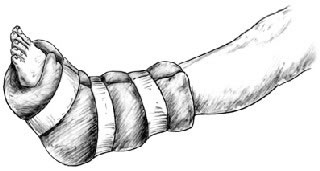Leg Injury
Is this your child’s symptom?
- Injuries to the leg (hip to foot)
- Injuries to a bone, muscle, joint or ligament
- Muscle pain caused by too much exercise or work (overuse). Overuse is covered in Leg Pain.
Types of Leg Injuries
- Fracture. This is the medical name for a broken bone. The most common broken bone in the leg is the tibia. The tibia is the largest bone in the lower part of the leg. Children with a fracture are not able to bear weight or walk.
- Dislocation. This happens when a bone is pulled out of its joint. The most common one in the leg is a dislocated kneecap (patella).
- Sprains. Sprains are stretches and tears of ligaments. A sprained ankle is the most common ligament injury of the leg. It’s usually caused by turning the ankle inward. Also, called a “twisted ankle.” The main symptoms are pain and swelling of the outside of the ankle.
- Strains. Strains are stretches and tears of muscles (a pulled muscle)
- Muscle Overuse. Muscle pain can occur without an injury. There is no fall or direct blow. Muscle overuse injuries are from sports or exercise. Shin splints of the lower leg are often from running up hills.
- Muscle Bruise from a direct blow. Bleeding into the quad (thigh muscles) is very painful.
- Bone Bruise from a direct blow (like on the hip). Called a “hip pointer.”
- Skin Injury. Examples are a cut, scratch, scrape or bruise. All are common with leg injuries.
Pain Scale
- Mild: Your child feels pain and tells you about it. But, the pain does not keep your child from any normal activities. School, play and sleep are not changed.
- Moderate: The pain keeps your child from doing some normal activities. It may wake him or her up from sleep.
- Severe: The pain is very bad. It keeps your child from doing all normal activities.
When to Call for Leg Injury
Call 911 Now
Call Doctor or Seek Care Now
|
Call Doctor Within 24 Hours
Call Doctor During Office Hours
|
Self Care at Home
|
Call 911 Now
- Major bleeding that can’t be stopped
- Serious injury with many broken bones
- Bone is sticking through the skin
- Looks like a dislocated joint (hip, knee or ankle)
- You think your child has a life-threatening emergency
Call Doctor or Seek Care Now
- Skin is split open or gaping and may need stitches
- Age less than 1 year old
- Severe pain and not better 2 hours after taking pain medicine
- Can’t move hip, knee or ankle normally
- Knee injury with a “snap” or “pop” felt at the time of impact
- You think your child has a serious injury
- You think your child needs to be seen, and the problem is urgent
Call Doctor Within 24 Hours
- Has a limp when walking
- Very large bruise
- Large swelling is present
- Pain not better after 3 days
- You think your child needs to be seen, but the problem is not urgent
Call Doctor During Office Hours
- Injury limits sports or school work
- Dirty cut and no tetanus shot in more than 5 years
- Clean cut and no tetanus shot in more than 10 years
- Pain lasts more than 2 weeks
- You have other questions or concerns
Self Care at Home
- Bruised muscle or bone from direct blow
- Pain in muscle from minor pulled muscle
- Pain around joint from minor stretched ligament
- Minor cut or scrape
Care Advice for Minor Leg Injuries
-
What You Should Know About Minor Leg Injuries:
- During sports, muscles and bones get bruised.
- Muscles get stretched.
- These injuries can be treated at home.
- Here is some care advice that should help.
-
Pulled Muscle, Bruised Muscle or Bruised Bone Treatment:
- Pain Medicine. To help with the pain, give an acetaminophen product (such as Tylenol). Another choice is an ibuprofen product (such as Advil). Use as needed. Ibuprofen works better for this type of pain.
- Cold Pack. For pain or swelling, use a cold pack. You can also use ice wrapped in a wet cloth. Put it on the sore muscles for 20 minutes. Repeat 4 times on the first day, then as needed. Reason: Helps with the pain and helps stop any bleeding. Caution: Avoid frostbite.
- Heat Pack. If pain lasts over 2 days, put heat on the sore muscle. Use a heat pack, heating pad or warm wet washcloth. Do this for 10 minutes, then as needed. Caution: Avoid burns. For stiffness all over, use a hot bath instead. Move the sore leg muscles under the warm water.
- Rest. Rest the injured part as much as possible for 48 hours.
- Stretching. For pulled muscles, teach your youngster about stretching and strength training.
-
Mild Sprains (stretched ligaments) of Ankle or Knee Treatment:
- First Aid: Apply ice now to reduce bleeding, swelling, and pain. The more bleeding and swelling there is, the longer it will take to get better. Wrap with an elastic bandage.
- Treat with R.I.C.E. (rest, ice, compression, and elevation) for the first 24 to 48 hours.
- Apply compression with a snug, elastic bandage for 48 hours. Numbness, tingling, or increased pain means the bandage is too tight.
- Cold Pack: For pain or swelling, use a cold pack. You can also use ice wrapped in a wet cloth. Put it on the ankle or knee for 20 minutes. Repeat 4 times on the first day, then as needed. Reason: Helps with the pain and helps stop any bleeding. Caution: Avoid frostbite.
- To help with the pain, give an acetaminophen product (such as Tylenol). Another choice is an ibuprofen product (such as Advil). Use as needed. Continue for at least 48 hours.
- Keep the injured ankle or knee elevated and at rest for 24 hours.
- After 24 hours, allow any activity that doesn’t cause pain.
-
Small Cut or Scrape Treatment
- Use direct pressure to stop any bleeding. Do this for 10 minutes or until the bleeding stops.
- Wash the wound with soap and water for 5 minutes. Try to rinse the cut under running water.
- Gently scrub out any dirt with a washcloth.
- Use an antibiotic ointment (such as Polysporin). No prescription is needed. Then, cover with a bandage. Change daily.
-
What to Expect:
- Pain and swelling usually peak on day 2 or 3.
- Most often, swelling is gone in 7 days.
- Pain may take 2 weeks to fully go away.
-
Call Your Doctor If:
- Pain becomes severe
- Pain is not better after 3 days
- Pain lasts more than 2 weeks
- You think your child needs to be seen
- Your child becomes worse
And remember, contact your doctor if your child develops any of the ‘Call Your Doctor’ symptoms.
Disclaimer: this health information is for educational purposes only. You, the reader, assume full responsibility for how you choose to use it.
Copyright 2000-2019 Schmitt Pediatric Guidelines LLC.






